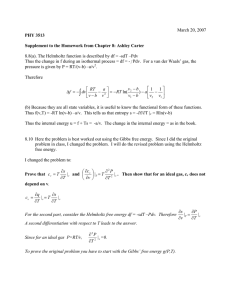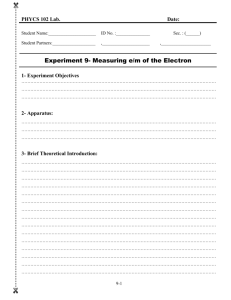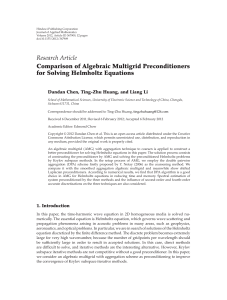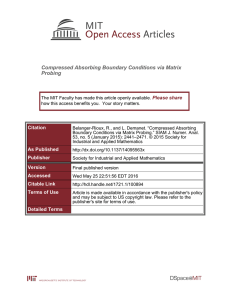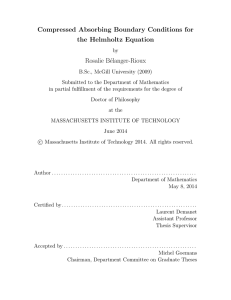A DDM double sweep preconditioner for the Helmholtz equation A. Vion
advertisement
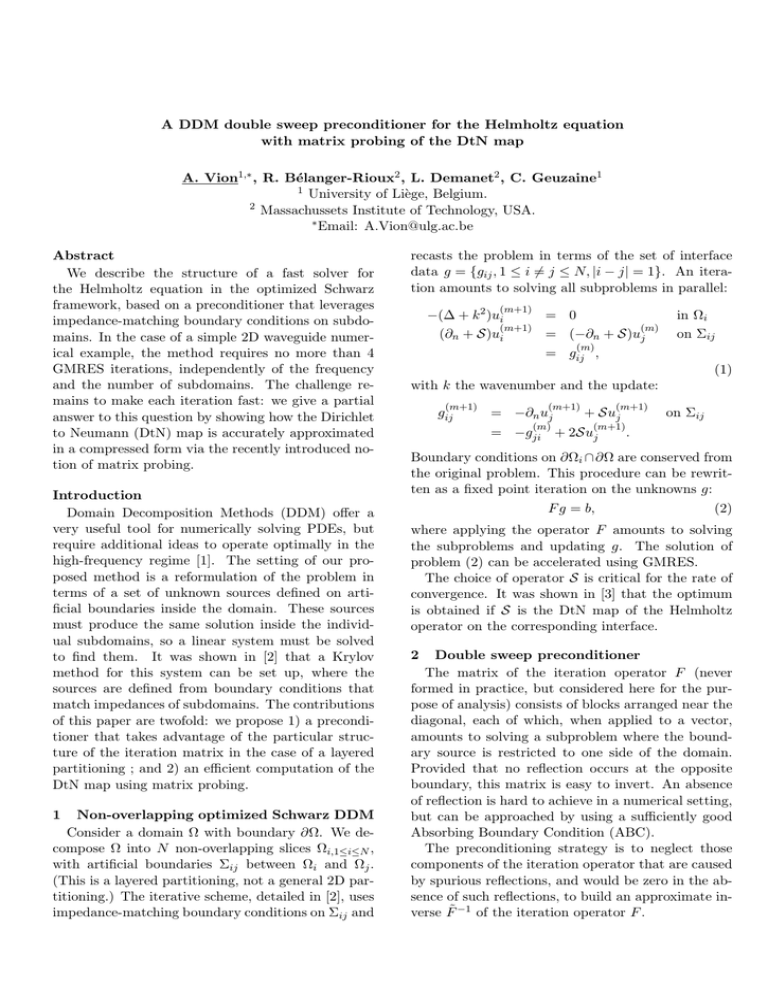
A DDM double sweep preconditioner for the Helmholtz equation
with matrix probing of the DtN map
A. Vion1,∗ , R. Bélanger-Rioux2 , L. Demanet2 , C. Geuzaine1
1 University of Liège, Belgium.
2 Massachussets Institute of Technology, USA.
∗ Email: A.Vion@ulg.ac.be
Abstract
We describe the structure of a fast solver for
the Helmholtz equation in the optimized Schwarz
framework, based on a preconditioner that leverages
impedance-matching boundary conditions on subdomains. In the case of a simple 2D waveguide numerical example, the method requires no more than 4
GMRES iterations, independently of the frequency
and the number of subdomains. The challenge remains to make each iteration fast: we give a partial
answer to this question by showing how the Dirichlet
to Neumann (DtN) map is accurately approximated
in a compressed form via the recently introduced notion of matrix probing.
Introduction
Domain Decomposition Methods (DDM) offer a
very useful tool for numerically solving PDEs, but
require additional ideas to operate optimally in the
high-frequency regime [1]. The setting of our proposed method is a reformulation of the problem in
terms of a set of unknown sources defined on artificial boundaries inside the domain. These sources
must produce the same solution inside the individual subdomains, so a linear system must be solved
to find them. It was shown in [2] that a Krylov
method for this system can be set up, where the
sources are defined from boundary conditions that
match impedances of subdomains. The contributions
of this paper are twofold: we propose 1) a preconditioner that takes advantage of the particular structure of the iteration matrix in the case of a layered
partitioning ; and 2) an efficient computation of the
DtN map using matrix probing.
1
Non-overlapping optimized Schwarz DDM
Consider a domain Ω with boundary ∂Ω. We decompose Ω into N non-overlapping slices Ωi,1≤i≤N ,
with artificial boundaries Σij between Ωi and Ωj .
(This is a layered partitioning, not a general 2D partitioning.) The iterative scheme, detailed in [2], uses
impedance-matching boundary conditions on Σij and
recasts the problem in terms of the set of interface
data g = {gij , 1 ≤ i 6= j ≤ N, |i − j| = 1}. An iteration amounts to solving all subproblems in parallel:
(m+1)
−(∆ + k 2 )ui
= 0
(m+1)
(m)
(∂n + S)ui
= (−∂n + S)uj
in Ωi
on Σij
(m)
= gij ,
(1)
with k the wavenumber and the update:
(m+1)
gij
(m+1)
= −∂n uj
=
(m)
−gji
+
(m+1)
+ Suj
on Σij
(m+1)
2Suj
.
Boundary conditions on ∂Ωi ∩ ∂Ω are conserved from
the original problem. This procedure can be rewritten as a fixed point iteration on the unknowns g:
F g = b,
(2)
where applying the operator F amounts to solving
the subproblems and updating g. The solution of
problem (2) can be accelerated using GMRES.
The choice of operator S is critical for the rate of
convergence. It was shown in [3] that the optimum
is obtained if S is the DtN map of the Helmholtz
operator on the corresponding interface.
2
Double sweep preconditioner
The matrix of the iteration operator F (never
formed in practice, but considered here for the purpose of analysis) consists of blocks arranged near the
diagonal, each of which, when applied to a vector,
amounts to solving a subproblem where the boundary source is restricted to one side of the domain.
Provided that no reflection occurs at the opposite
boundary, this matrix is easy to invert. An absence
of reflection is hard to achieve in a numerical setting,
but can be approached by using a sufficiently good
Absorbing Boundary Condition (ABC).
The preconditioning strategy is to neglect those
components of the iteration operator that are caused
by spurious reflections, and would be zero in the absence of such reflections, to build an approximate inverse F̃ −1 of the iteration operator F .
k = 10π
40π
N = 10
3
3
20
3
3
50
4
3
100
4
3
200
4
4
400
4
4
Table 1: Convergence of the method with double sweep
preconditioner and exact DtN map, applied to a rectangular waveguide with increasing number of subdomains N .
The iteration count (||r||2 /||r0 ||2 < 10−13 ) is small and
independent of N and wavenumber k.
By rearranging the terms of the matrix-vector
product g = F̃ −1 r, one can rewrite the preconditioner as a double sequence (forward and backward)
of subproblems solutions, each problem taking into
account the contribution of all its predecessors in the
sequence. So, considering the forward sequence, the
−1
−1
i-th component of g is: gi = ri + Hf,i
gi−1 , with Hf,i
the output of (1) for the i-th problem with impedance
data gi on the left and 0 on the right, and starting
with g1 = r1 . Such a sequence of solves is called a
sweep over the subdomains, hence the name of double sweep preconditioner.
The idea of sweeping was proposed in [4] for
preconditioning the Helmholtz equation. A double
sweep strategy was also proposed in [5]. These work
use the sweeps to precondition the Helmholtz operator in the original domain, while we use them to
precondition the operator F of a Schwarz method.
In addition, we precompute the DtN map by matrix
probing rather than by using perfectly-matched layers (PML), leading to potential computational savings. Because the complexity of applying a probed
DtN map hardly depends on its quality, we can use a
better ABC (thicker layer) in our precomputation,
hence potentially improved convergence properties
for the DDM algorithm.
3
DtN map approximation via probing
We are thus looking for an accurate approximation
D to the DtN map S at some interface Σ. Consider
the Helmholtz equation in a (PML) placed next to Σ.
The operator D is viewed as a black box that maps
Dirichlet data on Σ to the normal derivative, on Σ as
well, of the solution to the Helmholtz equation in the
PML: ∂n ū = Dū. We first precompute the matrix D
offline, then apply it to vectors on the fly as needed.
Matrix probing is used to make the precomputation of D tractable. Suppose that we wish to approximate a matrix D ∈ Rn×n , but we only have access
to a handful of products of D with vectors. We assume D can be written as a linear combination of a
P
small number of basis matrices Bj , D ≈ pj=1 cj Bj
fixed ahead of time. Under various assumptions, notably p n (see [6] for details) we can recover
the vector c with great accuracy using only a few
black box calls. For illustration, it is often advantageous P
to consider a single random vector z, so that
Dz ≈ pj=1 cj Bj z = Ψz c, where the Bj z are columns
of Ψz . Solving for c now requires the pseudo-inverse
of Ψz , which can be quickly obtained since this is an
n × p matrix with p n.
Hence we need a relatively small set of basis matrices which can accurately approximate the DtN map
D. There are different ways to do this: we can use
a geometrical optics approximation with oscillations
of the form eiωτ (x,y) times a parametrized singular
amplitude, see [7] for details, or else we can use the
relaxed terms of the Padé expansion proposed in [2],
obtained from a few 1D PDE solves. Both methods
reproduce the numerical results presented earlier.
Current work focuses on further lowering the complexity of each subdomain solve H −1 and each application of D. Preliminary results with a nonhomogeneous medium tend to indicate that the behaviour of the method is not fundamentally changed.
References
[1] O. Ernst and M. Gander, Why it is Difficult to
Solve Helmholtz Problems with Classical Iterative Methods, Numerical Analysis of Multiscale
Problems, 83 (2012), pp. 325–363.
[2] Y. Boubendir, X. Antoine and C. Geuzaine,
A quasi-optimal non-overlapping domain decomposition algorithm for the Helmholtz equation,
JCP, 231 (2012), pp. 262–280.
[3] F. Nataf, Interface Connections in Domain Decomposition Methods, NATO Science Series II,
75 (2001), pp 323–364.
[4] B. Engquist, L. Ying, Sweeping Preconditioner
for the Helmholtz equation: Moving Perfectly
Matched Layers, SIAM MMS, 9 (2011).
[5] C. Stolk, A rapidly converging domain decomposition method for the Helmholtz equation,
preprint (2012).
[6] J. Chiu and L. Demanet, Matrix Probing and its
Conditioning, SIAM J. Numer. Anal., 50 (2012),
pp. 171–193.
[7] R. Bélanger-Rioux and L. Demanet, Compressed
absorbing boundary conditions via matrix probing, preprint (2013).




